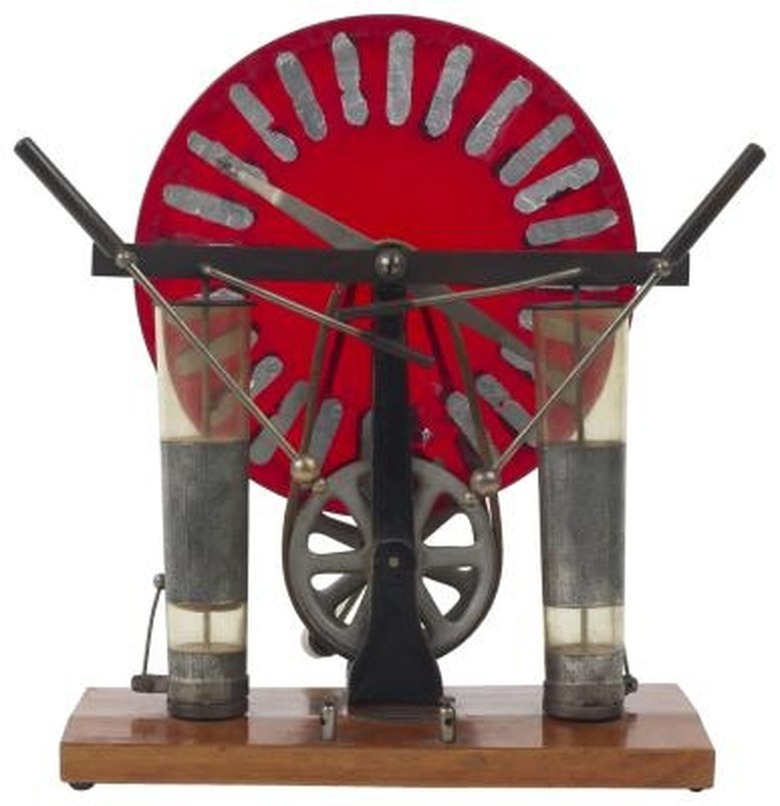How To Determine How Many Hybrid Orbitals
When atoms share electrons with other atoms to form chemical bonds, the orbitals that contain the electrons involved in the bonding merge to form a "hybrid" orbital. The number of hybrid orbitals formed depends on the number of electrons occupying the outermost orbitals, or the so-called valance shell. Chemists use hybrid orbitals to explain why various molecules assume certain geometric shapes.
Step 1
Draw the Lewis-dot structure of the molecule under consideration. This typically involves determining the number of valence electrons occupying the valance shell for each atom in the molecule; establishing one bond, which represents two electrons, between the central atoms and all other atoms; then adding double bonds as necessary to ensure that each atom possesses or shares a total of eight electrons. In carbon tetrachloride, or CCl4, for example, carbon represents the central atom and brings four electrons because it occupies group 4A in the periodic table; each chlorine atoms brings seven electrons because it occupies group 7A. The arrangement that gives each atom in the molecule eight electrons involves a single bond between carbon and each of the chlorine atoms, and each chlorine atom contains an additional six nonbonding electrons.
Step 2
Count the number of electron domains of the central atom in the molecule by noting the number of unpaired electrons and bonds on the central atom. Note that a single, double or triple bond each count as one electron domain. A lone pair of nonbonding electrons also counts as one electron domain. The carbon tetrachloride example from Step 1 consists of four single bonds to chlorine atoms and zero lone pairs of electrons, thus it contains a total of four electron domains.
Step 3
Determine the hybridization of the atom by correlating the number of electron domains determined in Step 2 to the appropriate hybridization scheme. The five major hybrids are sp, sp2, sp3, sp3d and sp3d2, which correspond to two, three, four, five and six electron domains, respectively. Carbon tetrachloride, with four electron domains, exhibits an sp3 hybridization scheme. This means that the central atom contains a total of four hybrid orbitals formed by combination of one s-type orbital and three p-type orbitals.
TL;DR (Too Long; Didn't Read)
Note that the numbers following the letters in the hybridization scheme sum to the number of electron domains on the central atoms. For example, sp2 corresponds to 1 + 2 = 3 electron domains, and sp3d2 corresponds to 1 + 3 + 2 = 6 electron domains.
References
- Davidson University, Department of Chemistry: Visualization of Atomic Orbitals: Hybrid Orbitals
- University of California Los Angeles, Department of Chemistry: Hybrid Orbitals
- Central Connecticut State University, Department of Chemistry: CCl4: Carbon Tetrachloride
- St. Olaf College: Electron Domains and Molecular Shape
Cite This Article
MLA
Brubaker, Jack. "How To Determine How Many Hybrid Orbitals" sciencing.com, https://www.sciencing.com/determine-many-hybrid-orbitals-8083273/. 24 April 2017.
APA
Brubaker, Jack. (2017, April 24). How To Determine How Many Hybrid Orbitals. sciencing.com. Retrieved from https://www.sciencing.com/determine-many-hybrid-orbitals-8083273/
Chicago
Brubaker, Jack. How To Determine How Many Hybrid Orbitals last modified March 24, 2022. https://www.sciencing.com/determine-many-hybrid-orbitals-8083273/
